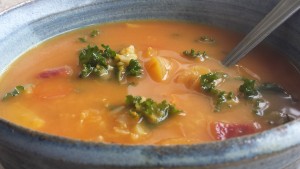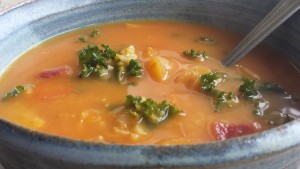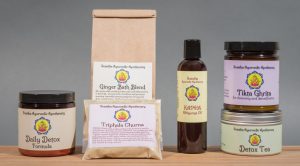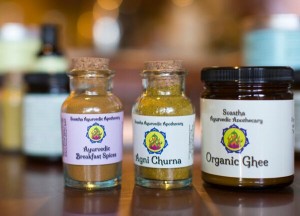Dal is the Sanskrit term for an Indian soup made from a split bean with its skin removed such as the red lentil. Because of these properties, red lentils are one of the easiest beans to digest, as they cook down to almost a sauce-like consistency. In fact, most individuals that have digestive issues with beans are still able to enjoy red lentils on a regular basis.
Red lentils are not only great due to their easy-to-digest properties, but this tiny bean possesses a great amount of health benefits as well! The red lentil is a powerhouse of vital nutrients including plant-sourced iron and protein, essential vitamin Bs, folate, zinc, phosphorous, manganese, fiber, copper, and potassium. Because of these nutrients, this mighty little bean is on the top 10 list for “Hair Healthy Foods“. When combined with the long list of vegetables that are included in this recipe, you will be set with a rainbow of colors, vitamins, minerals, and healing antioxidants.
This particular dal recipe is considered tridoshic and can be enjoyed by all body-types. It is also vegan, gluten-free, and grain-free making it a great meal choice for those with specific dietary needs. If you are not grain-free however, it is highly recommended to combine this soup with a rice or whole grain of your choice. My favorites are basmati rice, brown rice, millet, or quinoa, but feel free to explore!
Tridoshic Red Lentil Dal Recipe
Click here for a printable version of this recipe.
- Doshic effect: Vata↓, Pitta ↓, Kapha ↓ (may increase Pitta in excess)
- Vegan
- Gluten-Free
- Grain-Free
- Servings: 3 to 4 servings
- Prep Time: 5 minutes
- Cook Time: 35 minutes
Materials
- Large sauce pan or soup pot
- Cutting board and knife
Ingredients
- 2 tablespoon sesame oil (use coconut oil for Pitta)
- 1/4 teaspoon each of whole fennel, coriander, brown mustard, and cumin seed*
- 1/8 teaspoon freshly ground black pepper
- 1 tablespoon shredded coconut
- 1/2 teaspoon turmeric
- 2 cups split red lentils, soaked overnight
- 7 cups water, meat broth, or bone broth
- 1 large carrot, thinly sliced
- 2 celery sticks, thinly sliced
- 4 kale leafs, stemmed and chopped
- 1/3 cup chopped beets (omit for Pitta imbalances)
- 1/2 cup chopped cauliflower
- Fresh ginger (1 to 2 inch cube), peeled and finely minced
- 1 lemon, juiced (use lime for Pitta)
- Chopped cilantro, for garnish
- Chopped green onions, for garnish
- Ghee for individual servings
- 3/4 teaspoon sea salt or pink Himalayan salt
*These spices can be replaced by 2 teaspoons of Agni Churna spice mix.
Directions
Click here for a printable version of this recipe.
1. Heat a large sauce pan or soup pot over medium heat and add in the sesame oil. Once hot, add in the fennel, coriander, cumin, brown mustard seeds, and black pepper and sauté for 2 to 3 minutes, stirring frequently. Add in the coconut and turmeric and continue to sauté for 1 minute stirring constantly.
2. Add the water (or broth) in the same pan and bring to a boil. Once boiling, add the soaked red lentils (discard the water used for soaking) and stir. Reduce the heat to low-medium and cover the pan, leaving a slight opening to prevent the risk of overflow. Cook here for 10 minutes, stirring half way.
3. As the beans are cooking, begin to slice up the carrots, beet, cauliflower, celery, and kale.
4. After the 10 minutes if complete, add the chopped veggies to the pot, stir, and place back the lid keeping it slightly cracked. Cook here for 15 minutes or until the beans and veggies are very soft (almost mushy) and well-cooked. Stir every 4 to 5 minutes.
4. Remove the pan from the heat. Add the fresh lemon juice and salt.
6. This soup is great on its own or can be served over a warm bed of basmati rice, brown rice, or quinoa as desired. Garnish each serving with a handful of chopped cilantro and green onions. One teaspoon of ghee can be added per bowl. This tridoshic meal is most balancing in the fall and winter seasons, although you can enjoy it anytime of year!
Click here to see our full apothecary menu.






thank you so much for sharing! <3
Hi Edna,
Thank you for reading! I hope you enjoy the recipe:)
Many blessings,
Danielle
Hi, thanks for this!
When do we add the fresh ginger?
Sarah
HI,
Thank you for the recipe. Can you advise when to add the ginger? Also how to change the recipe to mitigate Kapha in the winter with too much mucous but mainly Vata.
Marcea